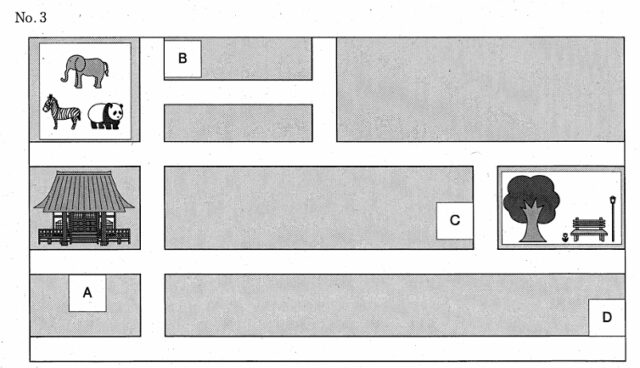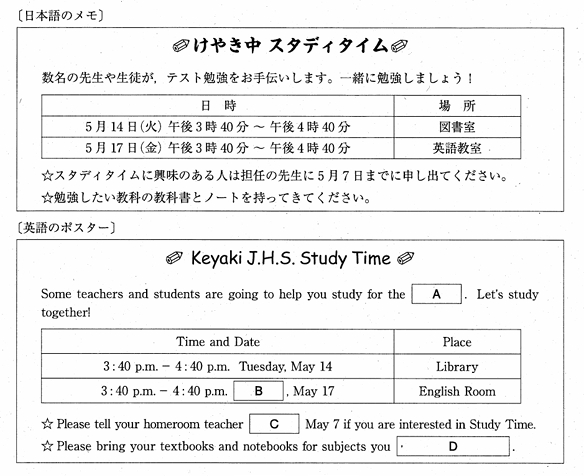■問題PDF(リンク)
■目次
大問1
大問2
大問3
大問4
大問5
■大問1(放送を聞いて答える問題)
問題1-1:問題は、No.1~No. 7 の全部で7題あり、放送はすべて英語で行われます。放送される内容についての質問にそれぞれ答えなさい。No.1~No. 6 は、質問に対する答えとして最も適切なものを、A~D の中から一つずつ選び、その記号を書きなさい。No.7 は、それぞれの質問に英語で答えなさい。放送中メモを取ってもかまいません。各問題について英語は2回ずつ放送されます。
【No.1~No.3】
Listen to each talk, and choose the best answer for each question.

解答 : D
問題1-2: Listen to each talk, and choose the best answer for each question.

解答 : B
問題1-3: Listen to each talk, and choose the best answer for each question.

解答 : A
問題1-4:【No.4, No.5】Listen to each situation, and choose the best answer for each question.
No.4
A Do not eat or drink.
B Please stand up.
C Take off your shoes.
D Do not enter.
解答 : A
問題1-5:No. 5
A OK. It’s red.
B Do you know what color it is?
C Do you have a bigger one?
D What a big T-shirt!
解答 : C
問題1-6(1):【No.6】
Listen to Mr. Jones. He’s an ALT at a junior high school. Choose the best answer for questions 1, 2 and 3.
(1) Question 1
A Because the students try to be quiet in English class.
B Because the students try to teach Mr. Jones Japanese.
C Because the students try to talk to Mr. Jones in English.
D Because the students try to use Japanese in English class.
解答 : C
問題1-6(2):(2) Question 2
A To introduce the shrine.
B To talk with her in English.
C To speak Japanese.
D To take a picture.
解答 : D
問題1-6(3):(3) Question 3
A Mr. Jones is talking about the history of Kyoto.
B English will help the students in the future.
C It’s important to talk with people about language.
D Mr. Jones must think about his friend in China.
解答 : B
問題1-7(1):【No.7】
Listen to the talk between Kenta and Emily, a student from the U.S., and read the questions. Then write the answer in English for questions 1, 2 and 3.
(1) Question 1: When did Kenta leave Aichi?
Answer: He left Aichi ( ) ago.
解答 : He left Aichi (two years) ago.
問題1-7(2):(2) Question 2: What will Kenta and Shinji do?
Answer: They will ( ) in the park.
解答 : They will (play baseball) in the park.
問題1-7(3):(3) Question 3: Why is Emily going to Tokyo next Saturday?
Answer: Because she is going to look for some English books about ( ) in Japan.
解答 : Because she is going to look for some English books about (nature) in Japan.
■大問2
問題2-1:生徒会本部役員の Yosuke が〔日本語のメモ〕をもとに、スタディタイムについてのポスターを、英語で作成します。〔日本語のメモ〕と〔英語のポスター〕を読んで、問1~問3 に答えなさい。

〔日本語のメモ〕をもとに、空欄 A C にあてはまる適切な1語を、それぞれ英語で書きなさい。なお、省略した形や数字は使わないものとします。
解答 : A:test B:Friday C:by
解説 : 日本語のメモをもとに英訳していく。
A:「for the test」=「テストの~」
B:「Friday」=「金曜」
C:「by」は「~まで」という、完了の期限を表す。
問題2-2:〔日本語のメモ〕をもとに、空欄 D に適切な3語以上の英語を書きなさい。

解答 : (例) want to study
解説 : 「~がしたい」=「want to do」
問題2-3:次は、Yosuke が ALT の Ms. Doyle に渡す英語のメモです。あなたが Yosuke なら、どのようなメモを書きますか。空欄 E に2文以上の英文を書きなさい。1文目は Could you に続けて、「Study Time に参加してくれませんか。」とお願いし、2文目以降は【語群】の中の語を1語のみ使ってその理由を書きなさい。

解答 : (例) Could you (join Study Time? We need your help to study English.)
解説 :1文目:「Could you~?」=「~してくれませんか?」、「join」=「参加する」
2文目:「We need your help~」=「あなたの助けが必要です。」
■大問3
問題3-1:次はニウエ (Niue) について Ryo がクラスで発表した英文です。これを読んで、問1~問5 に答えなさい。 印のついている語句には、本文のあとに〔注〕があります。
I think most of you know the country with the smallest population in the world. That’s right, it is *Vatican City. Now, how about the country with the second smallest population? The answer is Niue. The population of Niue was about 1,900 in 2020. Today, I would like to tell you about Niue.
A Niue is about 2,400 kilometers *northeast of New Zealand. It is one of the largest *coral reef islands in the world. It was a part of New Zealand but gained autonomy in 1974. B Its population was about 5,000 in 1963, but after an airport was opened in 1970, people left Niue. The population dropped to less than 2,000 about 20 years ago. In Niue, people grow fruits, such as bananas. However, there is ( ) *farmland and water to grow fruits to sell to other countries.Actually, there was not much industry in Niue. C The people of Niue realized that their country has a lot of nature and it can be used for tourist activities such as hiking in the forest.
I did not know that there (a / was / called / country) Niue until recently. I like to look at maps now, after learning about Niue. When I look at maps, I realize that there are still many countries that I do not know.
〔注〕population 人口, Vatican City バチカン市国 ,kilometer キロメートル, northeast 北東, coral reef サンゴ礁, gain autonomy 自治権を得る, grow ~ ~を栽培する, farmland 農地, industry 産業, recently 最近
本文中の A C のいずれかに、So, Niue needed to look for a way to make money, and found it. という1文を補います。
どこに補うのが最も適切ですか。 A C の中から一つ選び、その記号を書きなさい。
解答 : C
解説 :[本文の日訳]
「皆さんのほとんどは、世界で最も人口が少ない国をご存知だと思います。その通り、それはバチカン市国です。では、2番目に人口が少ない国はどこでしょうか?答えはニウエです。ニウエの人口は2020年には約1,900人でした。今日は、ニウエについてお話したいと思います。A
ニウエはニュージーランドの北東約2,400キロメートルに位置しています。それは世界最大のサンゴ礁の島のひとつです。かつてはニュージーランドの一部でしたが、1974年に自治権を獲得しました。B その人口は1963年には約5,000人でしたが、1970年に空港が開港した後、人々はニウエを離れました。人口は約20年前に2,000人以下に減少しました。
ニウエでは、人々はバナナなどの果物を育てています。しかし、果物を成長させ、他の国に売るための農地と水が不足しています。実際、ニウエにはあまり産業がありませんでした。C ニウエの人々は、自分たちの国には豊かな自然があり、森林でのハイキングのような観光活動に利用できることに気づきました。
私は最近までニウエという国があることを知りませんでした。ニウエについて学んだ今、地図を見るのが好きです。地図を見ると、まだ私が知らない国がたくさんあることに気づきます。」
「So, Niue needed to look for a way to make money, and found it. 」=「それで、ニウエはお金を稼ぐ方法を探す必要があり、そしてそれを見つけた。」
日訳より、問題の1文を補うのに最もふさわしいのはC。
問題3-2:下線部 ( ) にあてはまる最も適切なものを、次のア~エの中から一つ選び、その記号を書きなさい。
ア not enough イ full of ウ a few エ a lot of
解答 : ア
解説 :「not enough」=「~が足りない」
問題3-3:〔 〕内のすべての語を、本文の流れに合うように、正しい順序に並べかえて書きなさい。
解答 : I did not know that there [was a country called] Niue until recently.
解説 :下線部は「ニウエという国がある」という文を英語で表す。
「There+be動詞+名詞」で、ある場所や状況に何かが存在することを表す際に用いる構文。
問題3-4:本文の内容に関する次の質問の答えとなるように、( ) に適切な英語を書きなさい。
Question: What does Ryo like to do now, after learning about Niue?
Answer: He ( ) at maps.
解答 : He (likes to look) at maps.
解説 :質問の日訳:「リョウはニウエについて学んだ後、今、何をすることが好きですか?」
4段落目2文目に、「I like to look at maps now, after learning about Niue. 」とある。
問題3-4:本文の内容に関する次の質問の答えとなるように、( ) に適切な英語を書きなさい。
Question: What does Ryo like to do now, after learning about Niue?
Answer: He ( ) at maps.
解答 : He (likes to look) at maps.
解説 :質問の日訳:「リョウはニウエについて学んだ後、今、何をすることが好きですか?」
4段落目2文目に、「I like to look at maps now, after learning about Niue. 」とある。
問題3-5:本文の内容と合うものを、次のア~エの中から一つ選び、その記号を書きなさい。
ア Niue is the country with the smallest population in the world.
イ Ryo is interested in finding an island that is smaller than Niue on the map.
ウ People of Niue realized that they have nature that can be used for tourist activities.
エ Niue opened an airport in 1970 and its population was about 1,900 at that time.
解答 : ウ
解説 :問題文(ア~エ)の日訳
ア:ニウエは世界で最も人口が少ない国です。
→1段落3文目、4文目「Now, how about the country with the second smallest population? The answer is Niue. 」より、ニウエは二番目に人口が少ない国なので間違い。
イ:リョウは地図上でニウエよりも小さい島を見つけることに興味があります。
→そのような記載はないので間違い。
ウ:ニウエの人々は、自分たちの国には観光活動に利用できる自然があることに気づきました。
→3段落目4文目「 The people of Niue realized that their country has a lot of nature and it can be used for tourist activities such as hiking in the forest.」より、「ニウエの人々は自分たちの国には豊かな自然があり、森林でのハイキングのような観光活動に利用できることに気づきました。」とあるので正しい。
エ:ニウエは1970年に空港を開港し、その時の人口は約1,900人でした。
→1段目5文目「The population of Niue was about 1,900 in 2020.」より、人口が約1900人なのは2020年の時。2段目4文目、5文目「Its population was about 5,000 in 1963, but after an airport was opened in 1970, people left Niue. The population dropped to less than 2,000 about 20 years ago. 」より、空港を開港した時は人々はニウエを離れ、人口は約20年前に2000人以下に減少しているとあるので間違い。
■大問4
問題4-1:次の 1 ~ 4 は、中学生の Kento, Mandy と Jiro の会話です。これらを読んで、問1~問7 に答えなさい。*印のついている語句には、本文のあとに〔注〕があります。
1
(The students are trying to decide the topic for their presentation.)
Kento We have a presentation in class next week. What topic do you want to talk about?
Mandy Hmm, how about the Olympics? The next one will be held in Paris this summer. I hope to be there to watch the games.
Jiro That’s nice. Paris showed the next Olympics’ pictograms to the world.
Mandy Sorry. What are pictograms?
Jiro Pictograms are simple pictures that tell people information. They are used in many *public places, such as stations.
Kento Ah, I know. I have seen pictograms for the Paris Olympics on the Internet. They look cool. Some people say the athletes will feel proud of their sports when they see those pictograms.
Jiro New ones are made for every Olympics. The designs are different from city to city. What were the pictograms in the 2020 Tokyo Olympics like?
Kento Here they are. They are different from those in Paris, aren’t they?
Mandy Yes, they are simple. Why did Japanese people make simple pictograms?
Kento I don’t know why. I’m going to look for some books and websites to answer your question.
〔注〕Paris パリ,simple 簡素な, pictogram ピクトグラム, public place 公共の場所
下線部 your question のさす質問の具体的な内容を、日本語で書きなさい。
解答 :(例) なぜ日本の人々は簡素なピクトグラムを作ったのか。
解説 :[本文の日訳]
(生徒たちは発表のテーマを決めようとしている)
Kento: 来週、授業で発表があります。何のテーマについて話したいですか?
Mandy: うーん、オリンピックはどう?次のオリンピックは今年の夏にパリで開催されるわ。私はそこへ試合を見に行きたいな。
Jiro: いいね。パリは次のオリンピックのピクトグラムを世界に公開したよ。
Mandy: ごめん。ピクトグラムって何?
Jiro: ピクトグラムは、人々に情報を伝える簡単な絵だよ。駅のような多くの公共の場所で使われているんだ。
Kento: ああ、知ってるよ。僕はインターネットでパリ・オリンピックのピクトグラムを見たことがあるよ。あれらはかっこいいね。ピクトグラムを見ると、アスリートたちは自分たちのスポーツを誇りに思うだろうと言う人もいるよ。
Jiro: 新しいピクトグラムは、毎回のオリンピックで作られるんだ。デザインは都市ごとに異なるんだ。
Mandy:2020年の東京オリンピックのピクトグラムはどんな感じだった?
Kento: これだよ。パリのものとは違うよね?
Mandy: ええ、シンプルね。なぜ日本の人々はシンプルなピクトグラムを作ったのかしら?
Kento: なぜだかわからないな。君の質問に答えるために、いくつかの本やウェブサイトを探すつもりだよ。
下線部の指す質問は前文のMandyのセリフの「Why did Japanese people make simple pictograms?」である。これを日本語で書けばよい。
問題4-2:2
(The next day, the students are talking about the pictograms for the 1964 Tokyo Olympics.)
Kento Let me tell you about the 1964 Tokyo Olympics. Tokyo is the first city that used pictograms for the Olympics.
Mandy Why were pictograms used in the 1964 Tokyo Olympics?
Kento In the 1964 Tokyo Olympics, Japanese people needed to communicate with visitors from all over the world, but it was difficult to support visitors in the languages. So, Tokyo (to / had / way / another / think of) to communicate with everyone.
That was the pictogram.
Jiro I think many visitors from other countries could not understand Japanese.
Kento Right. For that reason, Tokyo decided to tell people important information through pictograms.
Mandy I see. Then, do you know who created the pictograms for the 1964 Tokyo Olympics?
Kento Yes, a group of designers started creating the pictograms. Katsumi Masaru, an *art critic, was one of them. The designers worked in small groups. One team was *working on sports pictograms. Another was working on pictograms for public places. Each group worked hard based on Mr. Katsumi’s idea. He thought the pictograms would play an important role in big events such as the Olympics.
〔注〕art critic 美術評論家, work on ~ ~に取り組む, based on ~ ~に基づいて , play an important role 重要な役割を果たす
問2 〔 〕内のすべての語句を、本文の流れに合うように、正しい順序に並べかえて書きなさい。
解答 :So. Tokyo [had to think of another way] to communicate with everyone.
解説 :[本文の日訳]
(翌日、生徒たちは1964年の東京オリンピックのピクトグラムについて話している)
Kento: 1964年の東京オリンピックについて話させてください。東京はオリンピックで初めてピクトグラムを使用した都市です。
Mandy: なぜ1964年の東京オリンピックでピクトグラムが使用されたのですか?
Kento: 1964年の東京オリンピックでは、日本の人々は世界中からの訪問者とコミュニケーションをとる必要がありましたが、訪問者を彼らの言語でサポートすることが困難でした。そこで、東京はすべての人とコミュニケーションをとるために別の方法を考え出す必要がありました。それがピクトグラムでした。
Jiro: 他の国からの多くの訪問者は日本語を理解できなかったと思います。
Kento: その通りです。そのため、東京はピクトグラムを通して人々に重要な情報を伝えることに決めたのです。
Mandy: なるほど。それでは、1964年の東京オリンピックのピクトグラムを誰が作ったのか知っていますか?
Kento: はい、デザイナーのグループがピクトグラムを作り始めました。美術評論家のカツミ マサルもその一人でした。デザイナーたちは小さなグループで作業しました。あるチームはスポーツのピクトグラムに取り組みました。別のチームは公共の場所のピクトグラムに取り組みました。各グループはカツミさんの考えに基づいて熱心に取り組みました。彼は、ピクトグラムがオリンピックのような大きなイベントで重要な役割を果たすだろうと考えていました。
本文の流れから、[ ]内は「別の方法を考えなければならない」という文になるように並べていく。
「have to~」=「~しなければならない」
「another way」=「別の方法」
問題4-3:問3 本文2の内容と合うように、次の英語に続く最も適切なものを、ア~エの中から一つ選び、その記号を書きなさい。
Pictograms were used in the 1964 Tokyo Olympics because
ア it was easy for Japanese people to speak foreign languages.
イ Tokyo wanted other countries to learn about Japanese culture.
ウ there were many designers who were interested in sports.
エ Japanese people needed to communicate with many visitors from other countries.
解答 : エ
解説 :[問題の日訳(ア~エ)]
“Pictograms were used in the 1964 Tokyo Olympics because”=「ピクトグラムが1964年の東京オリンピックで使用されたのは、」
ア:「日本の人々が外国語を話すのが簡単だったから。」
イ:「東京が他の国々に日本の文化について学んでほしかったから。」
ウ:「スポーツに興味のあるデザイナーがたくさんいたから。」
エ:「日本の人々が他の国々からの多くの訪問者とコミュニケーションをとる必要があったから。」
本文”Kento”の2回目のセリフ「In the 1964 Tokyo Olympics, Japanese people needed to communicate with visitors from all over the world, but it was difficult to support visitors in their languages. So, Tokyo had to think of another way to communicate with everyone. That was the pictogram.」より、最もふさわしいのはエ。
問題4-4:3
(The students continue talking.)
Jiro What were the pictograms for public places like?
Kento Here is an example. [Image 1] Have you ever seen this?
Mandy Yes, it means a restaurant.
Kento That’s right. This was used in Haneda Airport in 1964. Haneda Airport was an entrance to Japan for visitors from other countries at that time. Before that, there were *notices on the wall, but because most of them were written in Japanese, it was hard for many foreign visitors to understand what the notices said. So, pictograms were useful for making the information easier for foreign visitors to understand.
Jiro We often see such pictograms at the airports in Japan now.
Kento There were pictograms in public places before 1964. But each country had different pictograms. Mr. Katsumi and other designers tried to make simpler pictograms that everyone in the world could understand when they started getting ready for the 1964 Tokyo Olympics. Simple pictograms created by Japanese designers many years ago are still used around the world.
〔注〕notice 掲示 say ~と書いてある
問4 本文 3 の内容と合うものを、次のア~エの中から一つ選び、その記号を書きなさい。
ア Many visitors from other countries understood the notices at Haneda Airport before 1964.
イ Different pictograms for public places were made in each country before 1964.
ウ The pictograms Mr. Katsumi created were designed based on the Japanese language.
エ Many countries like their own pictograms better than the simple pictograms.
解答 :イ
解説 :[本文の日訳]
(生徒たちは話し合いを続けている)
Jiro: 公共の場所のピクトグラムはどんな感じだったの?
Kento: これが一例だよ。 これを見たことある?
Mandy: ええ、レストランっていう意味ね。
Kento: その通り。これは1964年に羽田空港で使われていたんだ。当時、羽田空港は他の国からの訪問者にとって日本の玄関口だったんだ。それ以前は、壁に掲示*があったんだけど、それらのほとんどが日本語で書かれていたから、多くの外国人訪問者にとって掲示の内容を理解するのが難しかったんだ。だから、ピクトグラムは外国人訪問者が情報を理解しやすくするのに役立ったんだ。
Jiro: 今、日本の空港でよくそういうピクトグラムを見かけるよね。
Kento: 1964年以前にも公共の場所にピクトグラムはあったんだ。でも、それぞれの国が異なるピクトグラムを使っていたんだ。カツミさんと他のデザイナーたちは、1964年の東京オリンピックの準備を始めたとき、世界中の誰もが理解できる、よりシンプルなピクトグラムを作ろうとしたんだ。何年も前に日本のデザイナーによって作られたシンプルなピクトグラムは、今でも世界中で使われているんだ。
[問題の日訳(ア~エ)]
ア:1964年以前、他の国からの多くの訪問者は羽田空港の掲示を理解していました。
→”Kento””の二つ目のセリフの「This was used in Haneda Airport in 1964. Haneda Airport was an entrance to Japan for visitors from other countries at that time. Before that, there were *notices on the wall, but because most of them were written in Japanese, it was hard for many foreign visitors to understand what the notices said. 」より、多くの外国人訪問者にとって掲示の内容を理解するのは難しかったとあるので間違い。
イ:1964年以前、公共の場所のための異なるピクトグラムが各国で作られていました。
→”Kento””の三つ目のセリフの「 There were pictograms in public places before 1964. But each country had different pictograms. 」より、正しい。
ウ:カツミ氏が作成したピクトグラムは、日本語に基づいてデザインされました。
→”Kento””の三つ目のセリフの「Mr. Katsumi and other designers tried to make simpler pictograms that everyone in the world could understand when they started getting ready for the 1964 Tokyo Olympics. Simple pictograms created by Japanese designers many years ago are still used around the world.」より、カツミ氏が作成したピクトグラムは世界中の誰もが理解できるシンプルなピクトグラムとあるので間違い。
エ:多くの国は、シンプルなピクトグラムよりも自国のピクトグラムを好みます。
→”Kento””の三つ目のセリフの「Simple pictograms created by Japanese designers many years ago are still used around the world.」より、シンプルなピクトグラムは今でも世界中で使われているとあるので、間違い。
問題4-5:4
(Kento shows another pictogram.)
Kento Now, many kinds of pictograms are used in public places. Have you seen this pictogram?
Mandy Yes, I have seen it in school. It shows a door that is used to leave the building when there is a fire or an earthquake.
Kento That’s right. It was created by Japanese designers and became an international standard in 1987. There is another example. Pictograms are often used on websites. Have you seen a “”magnifying glass icon?
Jiro [A] It means “*search.”
Kento Right. Pictograms are often used to tell people important information in a limited “space. One more example. [Image 3] Look, here is a small gift my friend in Australia gave me. You see it on the roads.
Jiro Oh, it means “”Be careful of kangaroos.” That’s easy. I would like to share it with our classmates. Why don’t we talk about the history of pictograms and those found in other countries for the presentation?
Mandy That’s a good idea. In our presentation, I would like to tell everyone that there are many pictograms around us. Let’s make the “slides and write a *script.
〔注〕building 建物, international standard 国際基準, magnifying glass icon 虫眼鏡のアイコン, search 検索, space 場所, road 道路, slide スライド , , script 台本
問5 下線部 this pictogram のさすものとして最も適切なものを、次のア~エの中から一つ選び、その記号を書きなさい。

解答 :ア
解説 :[本文の日訳]
(Kento が別のピクトグラムを見せる)
Kento: さて、多くの種類のピクトグラムが公共の場所で使われています。あなたはこのピクトグラムを見たことがありますか?
Mandy: はい、学校で見たことがあります。それは火事や地震があったときに建物から出るために使われるドアを示しています。
Kento: その通りです。それは日本のデザイナーによって作られ、1987年に国際標準になりました。もう一つ例があります。ピクトグラムはウェブサイトでよく使われます。虫眼鏡のアイコンを見たことがありますか?
Jiro: [A] それは「検索」という意味です。
Kento: その通り。ピクトグラムは限られたスペースで人々に重要な情報を伝えるためによく使われます。
Mandy:もう一つ例があります。見て、ここにオーストラリアの友達がくれた小さなプレゼントがあります。あなたはそれを道路で見かけます。
Jiro: ああ、それは「カンガルーに注意」という意味ですね。簡単です。それをクラスメートと共有したいです。発表でピクトグラムの歴史や他の国で見つかるピクトグラムについて話しませんか?
Mandy: いい考えね。私たちの発表で、私は私たちの周りにたくさんのピクトグラムがあることをみんなに伝えたいです。スライドを作って台本を書きましょう。
問題4-7:問7 次は、後日の Kento と Mandy の会話です。自然な会話になるように、( )に適切な 3語以上の英語を書きなさい。
Kento: The slides you made were very good. The pictogram quiz was also interesting.
Mandy: Thank you. I hope that our ( ) it.
Kento: I’m sure everyone will be interested.
Mandy: That would be nice. Is there anything else I can do for our
presentation?
解答 : (例) I hope that our (classmates will enjoy) it.
■大問5
問題5-1:5 次は、あなたが通う学校の英語の授業で、ALT の Ms. Moore が行ったスピーチです。これを読んで、問1~問3 に答えなさい。*印のついている語句には、本文のあとに〔注〕があります。
What did you do last night? I watched the rugby match between New Zealand and Australia on TV. I am from New Zealand, so I am a big fan of the New Zealand team. New Zealand and Australia have been long-time rugby rivals. The match I watched last night is called the *Bledisloe Cup. It is an international match that began around 1930 and holds a special meaning among many rugby fans. Both teams play several times a year. The Bledisloe Cup is usually held at stadiums in New Zealand or Australia, but it is sometimes held in other countries. It was held in Japan twice.
Have you ever heard the word “”*Haka””? It is a traditional dance in New Zealand. Some people say that it is performed as an expression of respect and gratitude. You will often see it at graduation ceremonies, sports matches, and many other events. Watching the dance, Haka, performed by the New Zealand team before the match also makes me excited. When I watch the dance, I realize the match will begin soon.
Last night’s match was exciting. It ended in a *tie, but it was a very good match. Actually, I am a member of a local rugby team and I play rugby on weekends. Sports are fun to watch and to play. Which do you like better, watching or playing sports?
〔注〕 long-time 長年の, Bledisloe Cup ブレディスローカップ, Haka ハカ, rival ライバル, international match 国際試合, gratitude 感謝, tie 引き分け
問1 本文の内容に合うように、次の英文の( )にあてはまる最も適切な1語を、本文中から抜き出して書きなさい。
Ms. Moore watched an international rugby match ( ) New Zealand and Australia.
解答 : between
問題5-2:問2 本文の内容と合うものを、次のア~エの中から一つ選び、その記号を書きなさい。
ア Ms. Moore は、昨夜スタジアムでラグビーの国際試合を観戦した。
イ Bledisloe Cup は日本で行われたことがある。
ウ Haka は、スポーツの国際試合のみでみられる伝統的な踊りである。 I New Zealand と Australia のラグビーの試合は毎年一回行われる。
解答 :イ
問題5-3:問3 下線部について、あなたはスポーツをみることとすることのどちらが好きかについて英語の 授業でスピーチをします。[条件]に従い、空欄の[A]に3文以上の英文を書いて、スピーチ原稿を完成させなさい。
スピーチ原稿
Hi, everyone. Today, I’m going to tell you how I enjoy spoets.
[A] Thank you.
[条件]
①1文目は、あなたはスポーツをみることとすることのどちらが好きか、I like に続けて、解答欄の①に書きなさい。
②2文目以降は、その理由が伝わるように、2文以上で解答欄の②に書きなさい。
解答 :①(例)I like playing sports better.
②(例) Playing sports is a kind of communication. I can communicate with other players through playing sports.







